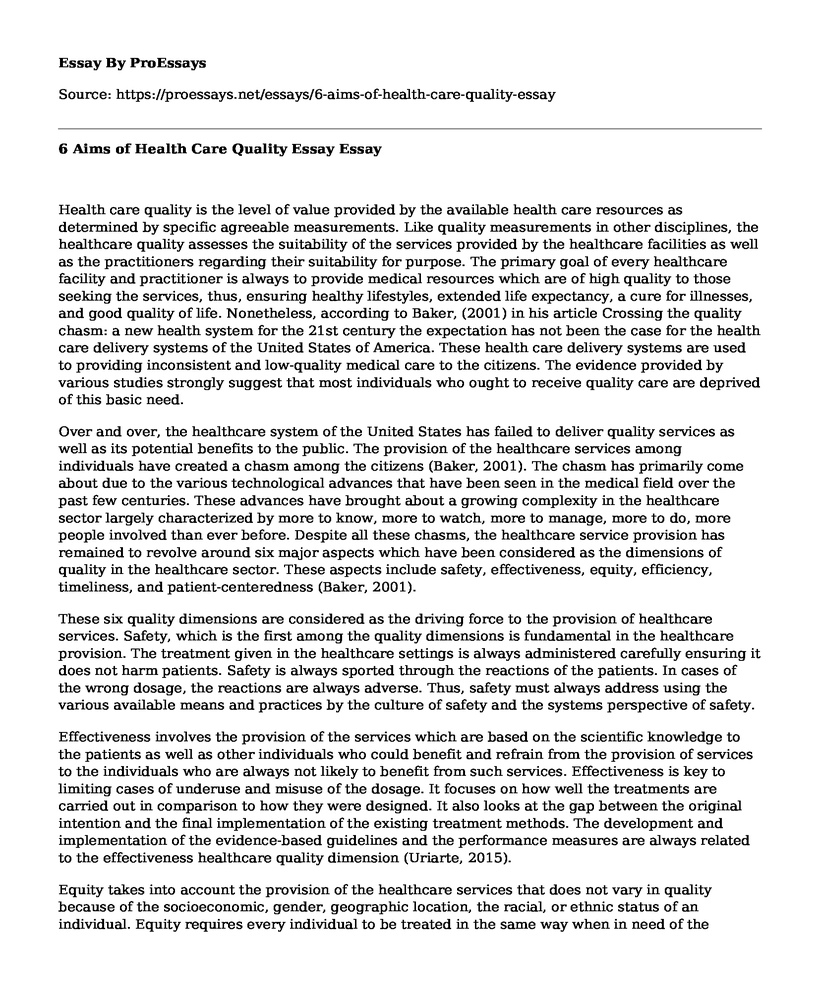Health care quality is the level of value provided by the available health care resources as determined by specific agreeable measurements. Like quality measurements in other disciplines, the healthcare quality assesses the suitability of the services provided by the healthcare facilities as well as the practitioners regarding their suitability for purpose. The primary goal of every healthcare facility and practitioner is always to provide medical resources which are of high quality to those seeking the services, thus, ensuring healthy lifestyles, extended life expectancy, a cure for illnesses, and good quality of life. Nonetheless, according to Baker, (2001) in his article Crossing the quality chasm: a new health system for the 21st century the expectation has not been the case for the health care delivery systems of the United States of America. These health care delivery systems are used to providing inconsistent and low-quality medical care to the citizens. The evidence provided by various studies strongly suggest that most individuals who ought to receive quality care are deprived of this basic need.
Over and over, the healthcare system of the United States has failed to deliver quality services as well as its potential benefits to the public. The provision of the healthcare services among individuals have created a chasm among the citizens (Baker, 2001). The chasm has primarily come about due to the various technological advances that have been seen in the medical field over the past few centuries. These advances have brought about a growing complexity in the healthcare sector largely characterized by more to know, more to watch, more to manage, more to do, more people involved than ever before. Despite all these chasms, the healthcare service provision has remained to revolve around six major aspects which have been considered as the dimensions of quality in the healthcare sector. These aspects include safety, effectiveness, equity, efficiency, timeliness, and patient-centeredness (Baker, 2001).
These six quality dimensions are considered as the driving force to the provision of healthcare services. Safety, which is the first among the quality dimensions is fundamental in the healthcare provision. The treatment given in the healthcare settings is always administered carefully ensuring it does not harm patients. Safety is always sported through the reactions of the patients. In cases of the wrong dosage, the reactions are always adverse. Thus, safety must always address using the various available means and practices by the culture of safety and the systems perspective of safety.
Effectiveness involves the provision of the services which are based on the scientific knowledge to the patients as well as other individuals who could benefit and refrain from the provision of services to the individuals who are always not likely to benefit from such services. Effectiveness is key to limiting cases of underuse and misuse of the dosage. It focuses on how well the treatments are carried out in comparison to how they were designed. It also looks at the gap between the original intention and the final implementation of the existing treatment methods. The development and implementation of the evidence-based guidelines and the performance measures are always related to the effectiveness healthcare quality dimension (Uriarte, 2015).
Equity takes into account the provision of the healthcare services that does not vary in quality because of the socioeconomic, gender, geographic location, the racial, or ethnic status of an individual. Equity requires every individual to be treated in the same way when in need of the healthcare services within the healthcare facilities. Despite the findings from the studies that show that some individuals do get better treatment than others, it is important to note that fairness must always be considered in every medical situation for the healthcare service delivered to be considered as one of quality (Uriarte, 2015).
Efficiency helps the healthcare service providers to maintain quality in the service delivery by avoiding waste. Efficiency helps in preventing the waste of supplies, energy, equipment, as well as ideas. Waste is defined as the used resources without the added benefits. Efficiency focuses on getting the best outcomes with the least amount of input.
Timeliness as one of the six aims is key to reducing the long waits experienced in some of the public sectors. Healthcare sector being a critical sector includes timeliness as one of the healthcare quality dimension to ensure waits are reduced as they may turn out to be harmful to the health caregivers as well as the receivers (Uriarte, 2015). Thus, the timeliness quality dimension is made up of two parts, which is the access and the system responsiveness.
Conclusion
The patient-centered healthcare service delivery is one of the most important qualities among the six aims of the healthcare quality. The patient-centeredness ensured the healthcare services are provided in a respectful manner which is in line with the preferences, the needs, as well as the values of the patient. Patient-centeredness also ensures the values of any given patient are used in guiding any clinical decision that may arise while dealing with the patients (Uriarte, 2015).
References
Baker, A. (2001). Crossing the quality chasm: a new health system for the 21st century. BMJ: British Medical Journal, 323(7322), 1192.
Uriarte, J. (2015). 6 Dimensions of Healthcare Quality [Image]. Retrieved from https://www.youtube.com/watch?v=QexTk38euzY
Cite this page
6 Aims of Health Care Quality Essay. (2022, May 26). Retrieved from https://proessays.net/essays/6-aims-of-health-care-quality-essay
If you are the original author of this essay and no longer wish to have it published on the ProEssays website, please click below to request its removal:
- Brief History of J.C. Penney - Case Study Example
- Anti-bias Curriculum: Communication With People With Disability
- Social Work Practice and Health Care Access Among Hispanic Immigrants
- Paper Example on Managing Obesity in Houston, TX: Possible Measures
- Airbnb's Success: From Start-Up to Enterprise Through Strategic Marketing - Essay Sample
- Rice Variety Transformation: Milling to Refine White Rice - Research Paper
- Essay Sample on ERP: Maximizing Business Resources & Info Flow







